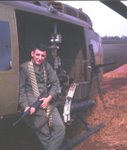Kilo-8 or “Night Hawk” was a night reconnaissance mission used to observe road traffic and provide flare coverage for patrols and units in contact. The helicopter used for this mission was a UH-1H with a large boom mounted search light in the left door. The search light had visible as well as infrared capability and could be directed using the umbilical with a joystick. We normally used the visible light selection but could use the IR feature by utilizing special binoculars that “saw” the invisible light beam.
 Doug Hensley, Senior Electronics Specialist for the Zenon light system
Doug Hensley, Senior Electronics Specialist for the Zenon light systemNight Hawk also carried a large amount of canister parachute flares. These flares had a cable lanyard that was hooked to any number of floor D-rings. All the crew chief or gunner had to do was heave one out the open door and the cable would start the ignition and parachute ejection sequence when the flare reached the end of the cable. They provided superb illumination, (several million candlepower) for the time they descended under the parachute. We had to be careful not to fly into them if we used the flares to accomplish an emergency extraction of someone in trouble. We also used the flares to mark a location on the ground as a target reference for AC-47 “Spooky” Air force fixed wing attack aircraft. We did this by flying low and slow and having the crew chief or gunner throw a flare out the door. The flare would ignite but being so low, would land on the ground without the parachute deploying and provide an excellent aiming point for the attack birds. All we had to do was tell Spooky which direction from the burning flare to place their fire and they would adjust accordingly. Spooky would put one round, (or bullet) every square inch on the ground. The sight was spectacular at night since every sixth round was a tracer and with six GE mini-guns shooting 6000 rounds per minute the effect was like a huge sheet of flame coming out of the sky. The sound on the ground was awe-inspiring as well and sounded something like a very loud baritone, “BAROOOOOOP”! The captured gooks that were interrogated after a strike called Spooky “The flaming tongue of death” or “Death from the sky” It was a lot of fun working with Spooky because we knew what these guys could do. They were aggressive, professional and eager to shoot. Toward the end of my tour, the “Super Spooky” AC-130 gunship was developed and had much greater firepower.
While flying Nighthawk we were frequently called upon to extract patrols that got into contact. These three or five man teams would set up ambush locations and frequently get in too deep with a superior force when they triggered the “Claymore” anti-personnel mines. We would get a call on our company frequency to change to an alternate frequency and contact the tactical call sign of the patrol in trouble. When we made contact we would invariably hear gunfire in the background, (sometimes in the foreground) and the situation was usually desperate, sometimes involving injured troops. The “RTO” or radio telephone operator would sometimes whisper because the contact was so close. We found the patrol using a variety of methods including “homing” on their radio transmission, visually locating a high intensity strobe light or simply finding the tracers from the ongoing firefight. Our tracers were yellow/orange appearing and the enemy’s tracers were a green color. This color difference made it easy to see where our guys were and determine what size of force they were up against. The patrol would try to break contact and make their way to an area we could at least hover to pick them up. We made approaches to strobes, smoke grenades and even Zippo lighters. Usually the guys would be formed up in a defensive perimeter, roughly an outward facing circle, and on our call would fire a short burst from their weapons to help us pinpoint where they were. When we finally got them on board our concern was mainly if there were any injured and that the entire patrol got out.
In this situation we sometimes received intense fire when on final approach and when departing the pickup area and our gunner and crew chief would return fire with their M-60 machine guns. The guys we picked up would join in with their M-16’s. We would take any wounded to the hospital at Pleiku Air Force Base and drop the rest at the helipad at Hensel field, Camp Enari or sometimes the "Oasis" West of Camp Enari.
The guys we pulled out occasionally came to visit us afterwards armed with whatever booze or beer that was available. We’d sit around getting hammered and telling each other how crazy we were to enjoy doing what we did. We developed deep respect for each other.




5 comments:
Hmmm, motley lookin crew there Mike! LOL And loved every bit I'm sure!
Really interesting stuff...sure glad you made it home!
Great images and details on Nighthawk missions. Im authoring a publication tentatively titled "Destroy by Darkness: Helicopter night warfare in Vietnam"
I'd love to add you as a contributor.
Sure! Email me and I'b be happy to be a contributor!
Blessings and good luck,
Mike
Very nice post. I just stumbled upon your blog and wished to mention that I have really loved browsing your blog posts.
In any case I'll be subscribing on your rss feed and I am hoping
you write once more soon!
Post a Comment